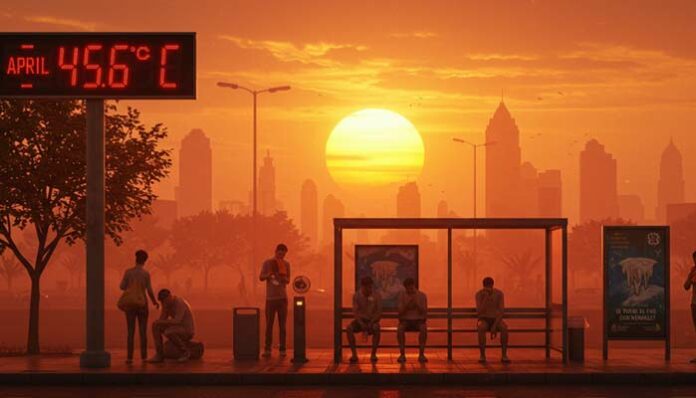You hear people talking about it everywhere, at the park, on benches, or at the bus stop with worried looks. This has never happened before, someone might say. And they’re right. The April heat isn’t just high; it’s refusing to go away. Every day, it’s still close to breaking records. The air feels heavier, as if there’s something going on that we don’t fully understand.
In Paris, scientists have been tracking the planet’s temperatures, and their findings are hard to ignore. April brought a heatwave that didn’t just feel hot, it stayed for much longer than expected. The temperatures stayed close to breaking records and didn’t seem to ease up. It’s almost like the Earth is holding onto heat, much more than we’re used to feeling.
At the beginning, many believed the heatwave would start to cool off as the El Niño conditions from last year began to fade. Typically, when those conditions end, the weather starts to feel better. But this time, it didn’t happen the way we expected. especially during April.
Johan Rockström, who leads the Potsdam Institute for Climate Impact Research, is worried about the situation. He pointed out that what we hoped would be a calmer period has instead become a cause for concern. Instead of things getting better, April showed that climate change is happening faster than ever, with no signs of slowing down.
What’s even more troubling is that we still don’t have answers. The reason for this change is still uncertain, and that makes it harder to find a solution. However, Rockström stressed that this uncertainty should be a warning sign, one we can’t afford to overlook if we want to make a difference before it’s too late.
The data shows that this heat isn’t limited to one area; it’s happening everywhere. It’s not just one place feeling the warmth, it’s a global issue. And the fact that April temperatures are being measured in so many locations around the world makes this information even more meaningful.
What’s even more troubling is that only one month has stayed within the safe range. All the others, Including April, are a clear sign that we’re heading toward a dangerous tipping point. The world is warming quicker than expected, and these numbers are a wake-up call about how serious the problem has become.
Failed to Reach the Goal
With the climate crisis unfolding before us, many scientists are now questioning if hitting this target is still realistic. What seemed like something we could achieve now feels almost impossible. The data, patterns, and trends are showing that we may already be beyond the point we were trying to stay below. And April just confirmed those fears.
A recent study, conducted by leading climate scientists, has revealed some troubling news about our planet’s warming. While the study is still waiting for peer review, its results have already sparked concern. The research shows that in 2024, global temperatures were 1.36°C higher than they were before industrialization, marking a noticeable rise. That rise was clearly reflected in April too.
This is more than just statistics or forecasts; it’s about the world we are building. The actions we take today will decide how quickly these temperature changes affect our lives and the planet. The reality that we’re approaching 1.5°C so soon should be a strong signal to all of us, a reminder that we must take action now, before it’s too late.
Samantha Burgess, a researcher at the European Centre for Medium-Range Weather Forecasts (which operates Copernicus), recently made an important statement. She explained that in just four years, the world is expected to exceed the 1.5°C limit, a level that many scientists have warned could trigger serious changes in the climate.
She’s telling us something important: we can’t waste time. We should stop aiming for the easier target of two degrees and focus on keeping global warming below 1.5°C. That smaller number might seem less urgent, but it’s the line between serious harm and even worse disasters. The clock is ticking, and we have to act now.
To him, passing the 1.5°C mark doesn’t mean it’s too late, it means we need to push forward with even more effort. We’re not out of choices yet. What we decide to do today will shape the kind of planet our children and grandchildren live on. If we stop now, we let the worst happen. But if we keep moving, we still have the power to change the outcome.
He explained that people often say even the smallest increase in temperature is important. These little changes might seem minor, but they can lead to serious effects, like more intense storms and longer droughts. Many of these effects started showing up around April.
The challenges we face can feel really tough, and sometimes it seems like we’re not making any progress. The problems are huge, and there are so many things in the way. It’s completely normal to feel down when the future looks so unclear.
Making a Real Difference
The cause of the climate crisis is clear: the burning of fossil fuels. Over the years, this has been steadily warming our planet, bringing us to the urgent situation we face today. April heat only made that more obvious.
Unusual heat like this is a clear warning that something isn’t right. It’s not just a one-time event, it’s part of a bigger shift happening around us. Understanding what’s driving these changes is key to finding better ways to cope and protect our future.
These little changes, when they happen together, could be making our planet warm up faster. To slow things down and protect what’s still here, we need to understand how everything is connected.
The way things are going, 2025 might also break records for high temperatures. It’s becoming clear that the planet is heating up faster, not slowing down, and the signs are all around us.
Burgess spoke seriously about the latest climate trends. He said the changes over the last two years have been more than just strange, they’ve been a clear sign that something is seriously wrong.
The problem is that being near the highest point of these predictions means we’re getting close to a critical point. The more we move into these extreme conditions, the tougher it will be to maintain balance and prevent even more serious effects.
However, she wasn’t entirely confident that this rapid warming will continue in the long run. It’s still too soon to tell, especially when we’re trying to predict what will happen in the next few decades.
Scientists also use ice cores, tree rings, and coral skeletons, all natural records that hold clues to the climate from centuries or even millennia ago. These natural archives help us understand long-term trends and see how the Earth’s climate has changed over time.
The rising temperatures are a clear signal that something is seriously changing. These shifts are unlike anything we’ve ever faced before, and it’s on us to figure out how we’ll manage what’s coming next.

